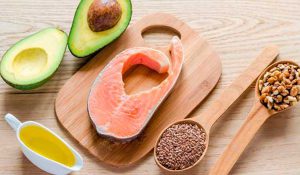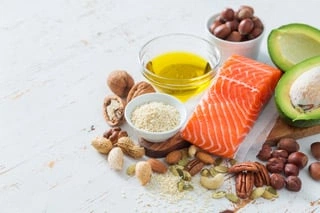
Why is vitamin D important and what is it?
There has been a lot of talk about this little substance lately. Have you already noticed that as of Jan. 1, 2023, vitamin D has been removed from the basic package of your health insurance? This applies to all doses of vitamin D, a combination of vitamin D with calcium or alendronic acid, and agents containing calcifediol (Hidroferol).
We are happy to tell you more about this important vitamin and which people should be especially vigilant for deficiency.
Vitamin D from sunlight
It can be produced by the skin under the influence of ultraviolet light, the sun. However, this is insufficient in practically all cases in our temperate climate zone. On top of that, people with dark skin have great problems making vitamin D. Also, we use sunscreen these days and it blocks the skin from making vitamin D.
Vitamin D from food
The only option that really remains then is to get enough from the diet. But even that is often another problem. Therefore, we see many fortified foods such as margarines, baking and frying butters that have vitamin D added to them. But margarine, baking and frying butter are precisely what we should not eat because these beat-up fats do more harm than good for you (aar what fats you should or should not eat is another topic).
As for vitamin D, oily fish forms a good basis. 100 grams of salmon = about 450I.E., 100 grams of herring = 800I.E. One tablespoon of cod liver oil provides 1400I.E. But watch out for the large amount of vitamin A in case of childbearing or pregnancy.
So, in my opinion, it remains necessary to get the right amount of vitamin D3 every day through a good dietary supplement (drops or capsules). The best absorbable form is vitamin D3 (cholecalciferol) of animal origin. This is converted by the liver and kidneys into the active form for the body, calcitriol. That way, you are assured of the correct dosage every day.
But what is that dosage? This has been the subject of discussion in recent years. Because, they argue, vitamin D can be toxic because it is fat-soluble. Most vitamins are water-soluble and therefore not toxic because they leave the body again through the urine when taken in excess.
Vitamin D (E and A too, for that matter) can be toxic, though. When vitamins were allowed to be sold freely in 1994, the maximum dosage was 200I.E. because people knew too little about it. The maximum dosage was set at 1000i.e (international units) per day by the Health Council in September 2008.
Unfortunately, still far below the desired dose of 2000i.e indicated by the international experts. While breastfeeding women, by the way, this would be 6000i.e. should be and that is what I recommend. Anyway, it’s another step in the right direction.
In any case, vitamin D is essential for good health. Since not too long ago, it has also been advised to infants. But rarely do I hear of expectant and breastfeeding mothers being advised to take extra vitamin D when they should. Unfortunately, relevant agencies are not sufficiently informed (yet).
Prevention of diseases Let’s see what vitamin D could do to solve or prevent diseases or deficiencies. This is really huge. I will mention to you the most important ones.
- It increases bone mass and thus combats osteoporosis (osteoporosis).
- As a result, it also prevents tooth loss, loose teeth and inflamed gums.
Winter depression is often associated with too little sunlight. Is this a coincidence? I don’t think so. Vitamin D was produced by the sun, right? A capsule or drops are cheaper than a ticket. I am, of course, not talking further about the possible fun of the vacation smiley . Further benefits:
- Lowering the risk of PMS , Premenstrual Syndrome. This affects nine out of ten women at the beginning of menstruation.
- Less lower back pain.
- Fewer respiratory problems such as COPD and acute respiratory infections.
- It strengthens the immune system and defenses against viruses.
- Improved fitness such as muscle strength and physical performance. This is interesting for athletes but also for the elderly, for example.
Thus, in people over 65, muscle strength, memory and concentration also improve. I am convinced that a large proportion of the elderly in retirement centers (or living independently) can get out from behind the walker with the right supplement. By the way, this group often lacks even more vitamins and nutrients (vitamin A, for example, for the eyes!). Supplementing this could make for a much more enjoyable old age.
Start on time! By starting young (from infancy), there is already prevention for things like breast cancer, asthma (so take it during pregnancy!), type-I diabetes (autoimmune disease).
Identifying Vitamin D deficiency How do you know if you are deficient? If it is very painful when you press your index finger on the breastbone, it may be an indication of vitamin D deficiency. But it could also be fibromyalgia, as the symptoms are very similar. In that case, I would go to the family doctor and ask for a referral for blood tests. A good vitamin D blood level for your health is 80nmol/liter or higher. A value higher than 250 is too high, then the toxic value is reached.
But even a one-time dose of 100,000I.E. is completely safe and can even be therapeutically effective. Risks seem to start forming only with chronic use higher than 10,000I.E. per day.
For now, investigations will continue. Let’s see what the next recommendation will be from the health council. 2000 I.E.?
In any case, I recommend taking at least 2000ie of vitamin D3 every day to maintain good health. The dosage remains dependent on several factors. So get good advice and don’t just swallow anything. More is not always better, either.

